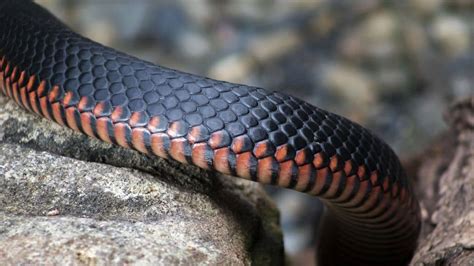Maine is home to a variety of snake species, but are any of them poisonous? The answer is yes, but only one species of snake in Maine is venomous: the timber rattlesnake.

What is the Timber Rattlesnake?
The timber rattlesnake (Crotalus horridus) is a venomous snake found in eastern North America, including Maine. It is a large snake, with adults typically reaching lengths of 3-5 feet. The timber rattlesnake has a distinctive pattern of black and brown bands along its body, and a triangular head with a pit between its eyes and nostrils.
How Venomous is the Timber Rattlesnake?
The timber rattlesnake’s venom is a powerful neurotoxin that can cause a variety of symptoms, including pain, swelling, nausea, vomiting, and dizziness. In severe cases, a timber rattlesnake bite can be fatal. However, it is important to note that timber rattlesnakes are not typically aggressive, and they will only bite if they feel threatened.
What to Do if You Are Bitten by a Timber Rattlesnake
If you are bitten by a timber rattlesnake, it is important to seek medical attention immediately. The venom can be fatal if not treated promptly. While you are waiting for medical help to arrive, you should follow these steps:
- Remain calm and still.
- Immobilize the bitten limb.
- Clean the wound with soap and water.
- Apply a cold compress to the wound.
- Drink plenty of fluids.
How to Avoid Being Bitten by a Timber Rattlesnake
The best way to avoid being bitten by a timber rattlesnake is to be aware of their presence and to take precautions when hiking or camping in areas where they are known to live. Here are some tips:
- Stay on marked trails.
- Wear long pants and boots.
- Be aware of your surroundings and look for snakes.
- Do not approach snakes, even if they appear to be dead.
- If you see a snake, give it plenty of space and move away slowly.
Other Snakes in Maine
In addition to the timber rattlesnake, there are several other species of snakes in Maine. These snakes are not venomous, but they can still bite if they feel threatened. The most common non-venomous snakes in Maine include:
- Eastern garter snake (Thamnophis sirtalis)
- Northern red-bellied snake (Storeria occipitomaculata)
- Eastern hognose snake (Heterodon platirhinos)
- Smooth green snake (Opheodrys vernalis)
- Ring-necked snake (Diadophis punctatus)
Conclusion
While the timber rattlesnake is the only venomous snake in Maine, it is important to be aware of all snakes and to take precautions to avoid being bitten. By following these tips, you can help reduce your risk of being bitten and enjoy the outdoors safely.
FAQs
Q: Are there any other venomous snakes in Maine?
A: No, the timber rattlesnake is the only venomous snake in Maine.
Q: What are the symptoms of a timber rattlesnake bite?
A: The symptoms of a timber rattlesnake bite can include pain, swelling, nausea, vomiting, and dizziness. In severe cases, a timber rattlesnake bite can be fatal.
Q: What should I do if I am bitten by a timber rattlesnake?
A: If you are bitten by a timber rattlesnake, it is important to seek medical attention immediately. While you are waiting for medical help to arrive, you should remain calm and still, immobilize the bitten limb, clean the wound with soap and water, apply a cold compress to the wound, and drink plenty of fluids.
Q: How can I avoid being bitten by a timber rattlesnake?
A: The best way to avoid being bitten by a timber rattlesnake is to be aware of their presence and to take precautions when hiking or camping in areas where they are known to live. Stay on marked trails, wear long pants and boots, be aware of your surroundings and look for snakes, do not approach snakes, even if they appear to be dead, and if you see a snake, give it plenty of space and move away slowly.
